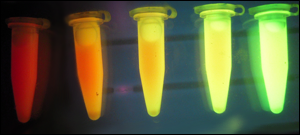Team:KIT-Kyoto/Protocol
From 2010.igem.org
(Difference between revisions)
(→Protocol) |
(→Protocol) |
||
| Line 40: | Line 40: | ||
<tr><td width="50%"> | <tr><td width="50%"> | ||
<span id="tf">'''トランスフォーメーション'''</span></td><td><span id="tfeng">'''Bacterial transformation'''</span></td></tr> | <span id="tf">'''トランスフォーメーション'''</span></td><td><span id="tfeng">'''Bacterial transformation'''</span></td></tr> | ||
| - | <tr><td> | + | <tr><td>↓氷上でコンピテント細胞(DH5α:大腸菌株)を融かす</td><td>↓Thaw competent cells(DH5 Alpha:<I>E.coli</I> strain) on ice.</td></tr> |
| - | <tr><td> | + | <tr><td>↓前もって冷やしておいた1.5 mlチューブに100 μlのコンピテント細胞を分注する:余ったコンピテント細胞は-80 ℃の冷凍庫に戻す</td><td>↓Aliquot 100 μl cells into pre-chilled 1.5 ml tube.Put excess competent cells back into the -80℃ freezer.</td></tr> |
| - | + | ||
| - | :余ったコンピテント細胞は-80 ℃の冷凍庫に戻す</td><td>↓Aliquot 100 μl cells into pre-chilled 1.5 ml tube.Put excess competent cells back into the -80℃ freezer.</td></tr> | + | |
<tr><td>↓DNAをチューブに1~5 μl加えて、氷上で30分間冷やす</td><td>↓Add DNA (1 to 5 μl) to tube, incubate on ice for 30 minutes.</td></tr> | <tr><td>↓DNAをチューブに1~5 μl加えて、氷上で30分間冷やす</td><td>↓Add DNA (1 to 5 μl) to tube, incubate on ice for 30 minutes.</td></tr> | ||
<tr><td>↓42 ℃で45秒間熱ショックを与える</td><td>↓Heat shock the cells at 42 ℃ for 45 seconds. </td></tr> | <tr><td>↓42 ℃で45秒間熱ショックを与える</td><td>↓Heat shock the cells at 42 ℃ for 45 seconds. </td></tr> | ||
Revision as of 08:43, 23 October 2010
 
|
Language : English / Japanese |
About protocolAs it is of common knowledge, iGEM is carried out within the framework of a protocol common to all teams. Whereas most of the teams are registered on this page, we have uploaded not only the English protocol but also the Japanese one, e.g., our mother tongue version. This is the common protocol with some improvements after we translated it into Japanese.Publishing the Japanese protocol in will be of help to other new Japanese teams in the future. Furthermore, this will be linked to an improvement of iGEM’s name identification in Japan and will enhance the public recognition of synthetic biology. It will also promote Science and Communication among people within not only the scientific but with the non-scientific communities as well. We believe that these improvements will constitute a contribution to the illustration of the public in general.
Contents
|
 "
"









